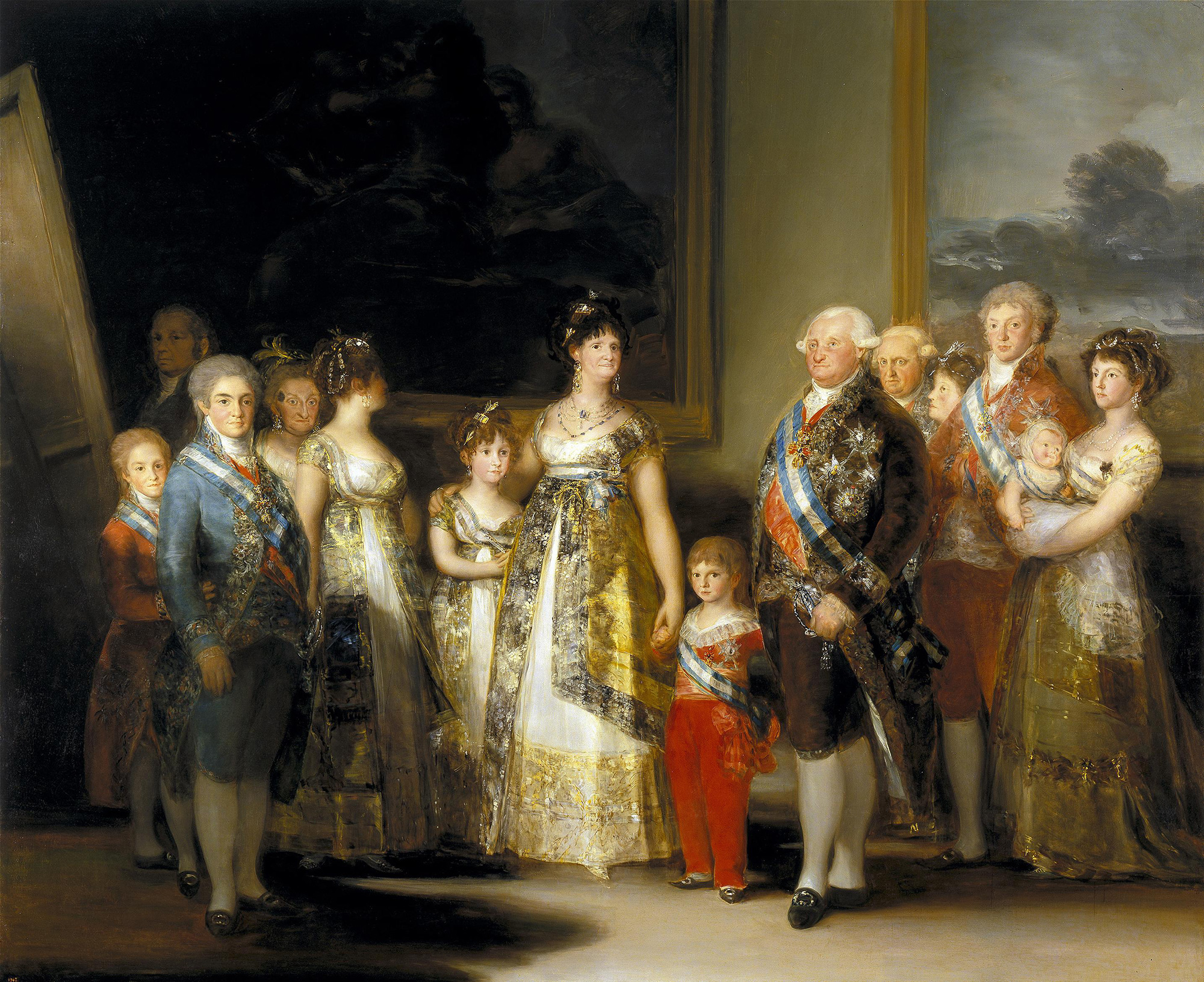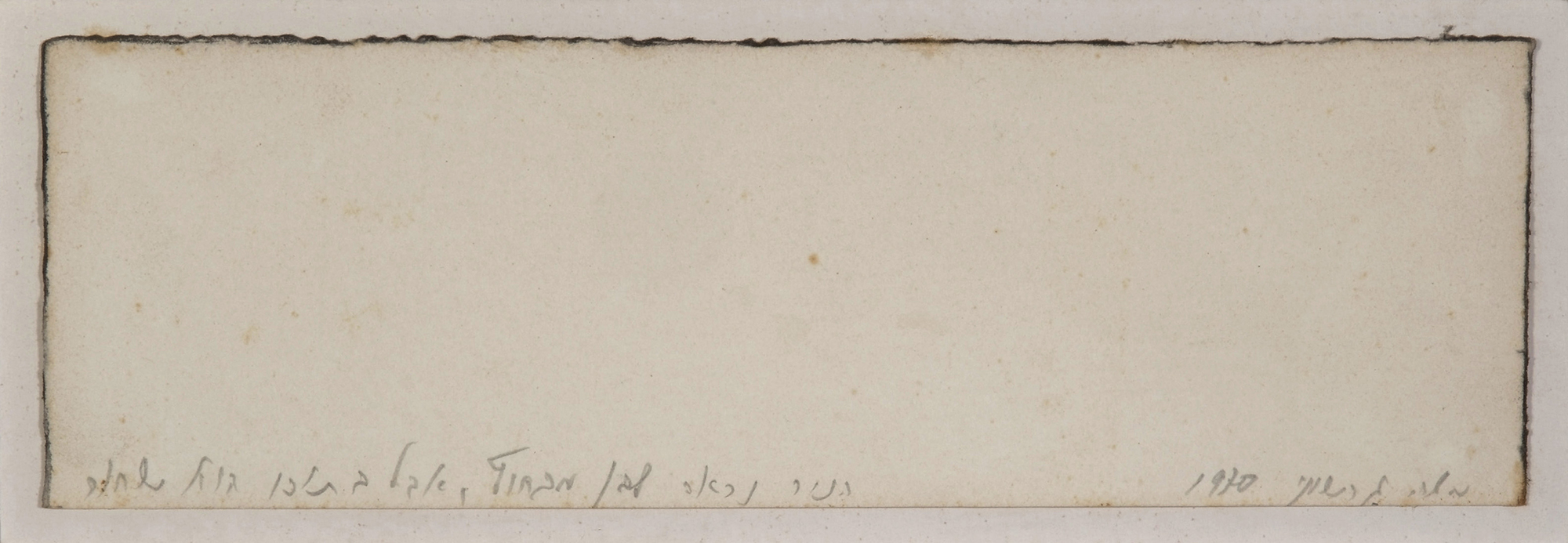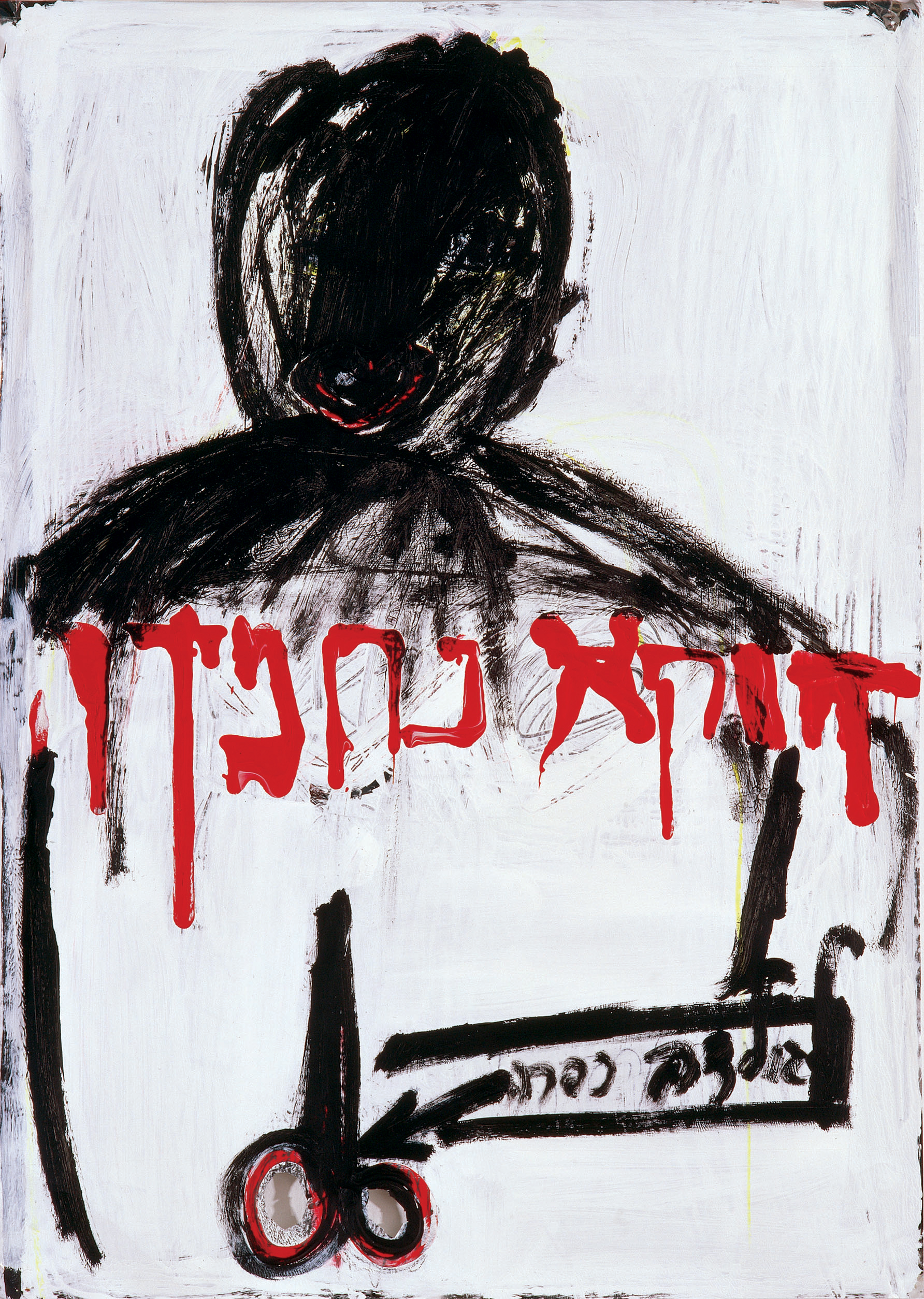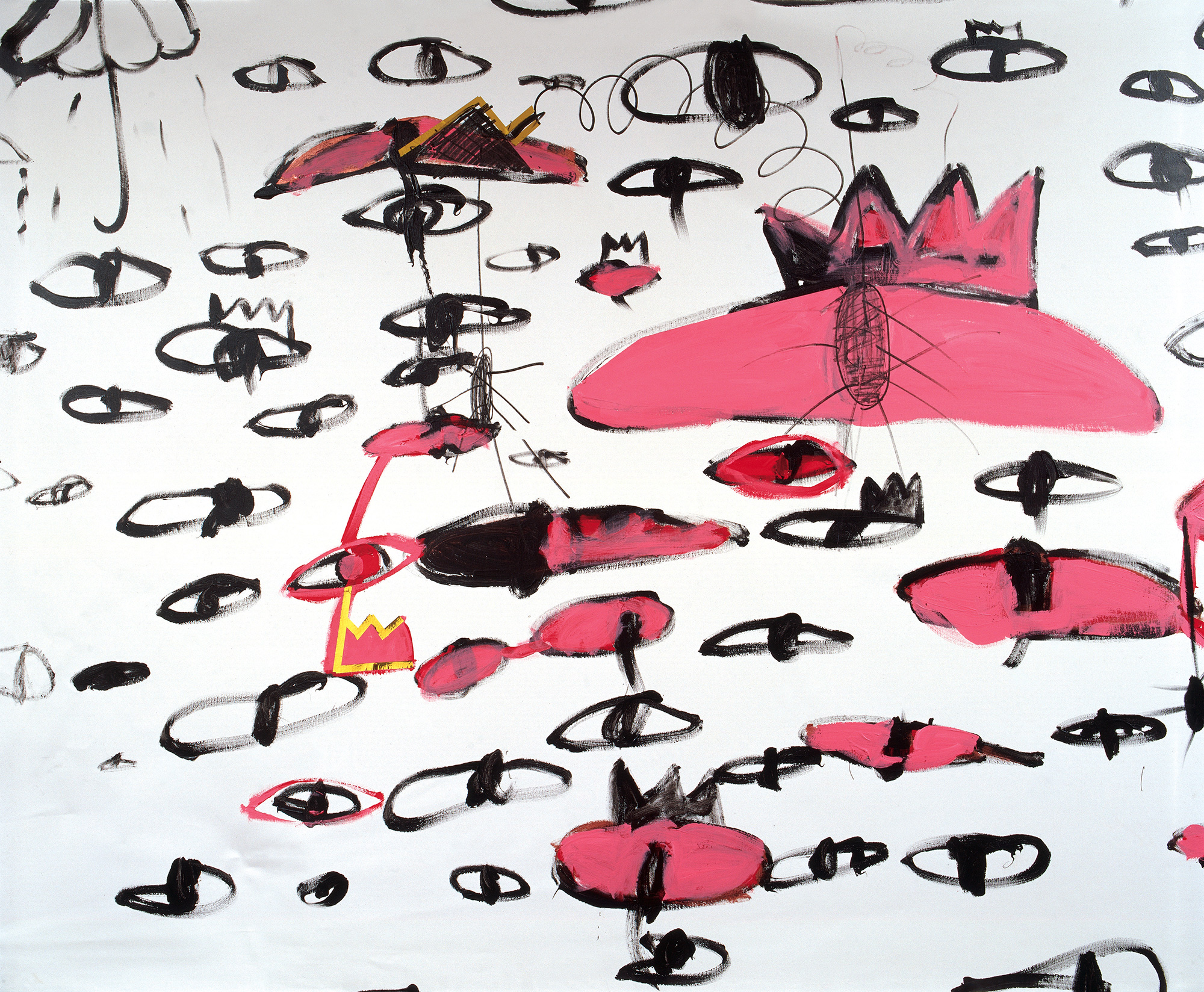KHEN SHISH
☰
☰
x
- ← On Khen Shish’s Birthday
- Tal Ben Zvi
- 2003
Khen Shish’s exhibition “Birthday” opened on her birthday. Shish, whose works have dealt extensively with the position of the biographical agent and with various aspects of Mizrahi identity,” (1) chose to place the personal biographical dimension in the current exhibition in the genealogy of the Israeli art field as an imaginary family biography.
In the gallery space Shish installed scores of drawings executed on stickers, paper scraps, oak tag, and canvas, so that torn eyes, scratches, black hearts, stems, petals, flowers, and more eyes, burst forth from each of the Gallery’s drawing-filled rooms. All were executed in swift, ostensibly slipshod, linear drawing that introduced a unique, personal handwriting typified by obsession and intensity. In many press reviews about the exhibition, the critics noted a link between Shish’s work and artistic precedents. (2) Gilad Meltzer (3), for example, described Shish’s affinity with the canon of Israeli painting:
The exhibition emphasized Shish’s profound affinity with the canon of the older generation in Israeli painting, skillfully maneuvering between slovenly eruption and accurate restraint: Shish’s depictions of near-upright, slightly drooping stalks recall Raffi Lavie’s quivering line and Yoav Efrati’s evasive drawing. The greatest surprise for me was the black flower paintings which resemble Gershuni, but without the morbid historical baggage.
Yoav Shmueli (4) also discussed Shish’s handwriting in the context of the Israeli canon:
It is an unresolved work – on the one hand, the traces of her handwriting leave no room for doubt: she is clearly talented […]; on the other, her somewhat parasitical choreographed dance steps with the painterly language of Raffi Lavie, Moshe Gershuni, and Aviva Uri – and, in contrast, the more interesting and surprising steps with that of Jean Michel Basquiat, under her seemingly confident orchestration, are confusing and challenging.
In the sequence of artistic associations between Beuys, Gershuni, Aviva Uri, Raffi Lavie, and Basquiat, Shish seems to elude her critics. At the same time, the artist’s two works, presented side by side, seem to conceal a code for deciphering the association between the canon and her works. The first work follows a 1970s reproduction by Moshe Gershuni. Gershuni originally decorated Goya’s reproduction (5) with red margins, and on the figure of the 17th century woman portrayed in it he inscribed the words “Golda Meir” in red. Shish uses Gershuni’s photographic reproduction as published in the Israeli art magazine Studio. She leaves it as is, but chooses to gouge out the queen’s eyes.
Shish tore Gershuni’s reproduction out of a special issue of Studio (#143, 2003) dedicated entirely to the artist, Israel Prize Laureate for painting, and his refusal to accept the prize in the presence of Prime Minister, Ariel Sharon. In this respect, Gershuni’s criticism of the government and establishment at the time of the award reception is a continuation of Goya’s criticism when he depicted the Spanish royal court as corrupt; at the same time, it is also a continuation of Gershuni’s criticism of Golda Meir after the Yom Kippur War (1973). This chain of criticism, however, seems to remain within the bounds of the Israeli hegemonic discourse; this may account for the fact that Shish tears, sterilizes, and perforates the hegemonic critical gaze, leaving it empty and hollow.
Gershuni’s reproduction was published in Studio on a two-page spread, juxtaposed with another work, also from the 1970s: a white page on which he inscribed the sentence “The paper looks white from the outside but inside it is black.” Discussing this piece Ellen Ginton (6) notes that Gershuni’s logic of displacement, from the outside in, is one that conjures up the (politically as well as sexually) repressed. The otherness signified in the work remains under the surface, and is represented only through language in a dichotomous inside-outside, black-white binary system. Shish tears this work out of a magazine, perforates a heart shape in the page, and installs the work on a flickering television monitor placed on the gallery floor, letting the dots flashing on screen bathe and illuminate the heart at the bottom of the page.
But instead of the invisible blackness which transpires as a mere lyrical option in the original spread, Shish introduces the “black” face most quintessentially charged with otherness, blackness, and Orientalism. A black stain appears on the page, a black face of sorts entirely rubbed out; underneath it, in red letters dripping like blood, she writes “rather nice,” adding at the bottom, in black: “Golda Pardons” with an arrow pointing at an object resembling either scissors or a phallic image whose testicles are hollowed like the queen’s eyes in Gershuni’s reproduction.
The phrase “rather nice” immediately connotes the Israeli Black Panthers. Shish’s words are like a self statement in feminine form referring to Golda Meir’s claim against the Black Panthers at the beginning of the Mizrahi struggle, that they are “not nice.” In response to Gilad Meltzer’s description of her works as “Gershuni, but without the morbid historical baggage,” Shish inundates the works with a historical narrative of repression, charging the historical narrative with the feminine semantics, thus transforming the male Black Panther into a tigress. The scissors or empty testicles indicate castration of a masculine sphere, a realm of canonical language, the paternal language embodied by the dynasty of Israeli art reviewed at length above.
From the pair of works, by Gershuni/Goya and by Shish, installed at the entrance to the gallery, the gaze splits into several rooms and scores of piercing black eyes, black hearts, and countless scribbles and lines generating a chaos of sorts with inner logic. Dalia Marcovitz (7) analyzed this logic in her review of the exhibition, with reference to Franz Fanon’s writing:
In the dialectic created between the white and the black, the black gaze undermines itself. It attempts to swallow the white as a model for imitation. At the same time it digests its inferior reflection as assimilated in the white world. The norms of observation dictated by the world seem not to apply to Shish’s eyes. The submissive, servile gaze which strives to assume the appearance of the other is replaced by dozens of piercing eyes […]. Khen Shish strives to free the gaze of authority, the “gaze” that has transformed into the domesticating, sublimating “self gaze”. The eyes in the exhibition respond to this call. Manically and powerfully they roam around the space, directing a black gaze at Israeli society.
In another critical essay, Ruti Direktor (8) addresses the critical option of contemporary art as manifested in Shish’s exhibition and in Eli Petel’s exhibition “Neo Soul” concurrently exhibited at Dvir Gallery: (9)
Both Eli Petel and Khen Shish seem to take suicidal artistic measures – Petel in his choice of bizarre photographic themes and the ostensibly non-artistic mode of painting; Shish in her brush with the banal and kitschy and in the romanticizing of drawing as a continuation of the body and the self. Both their appearances rub shoulders with the non-high, less-artistic, less-sophisticated. Both indirectly touch upon Israeliness.
In the concluding paragraph of her review, Direktor asks whether Mizrahi identity may be regarded as a metaphor for progressing in a side path of art, one typified by relinquishing a standard appearance. In a sense, Shish’s erupting, excessive linear drawing is not a side path of Israeli art, but rather its re-definition. Shish in fact creates a stamp of approval, at once adoptive and defiant. The sole line repeated on each page indeed operates within the glorification of the line as part of the tradition of modern drawing; (10) the latter, however, is confronted with both a chaotic multiplicity and with eruptions of words and sentences: ‘Golda Meir,’ ‘Golda Pardons,’ ‘rather nice,’ ‘tigress,’ ‘honey,’ ‘Lag Ba’Omer, may you burn,’ ‘space,’ etc. – each individually and all together take the viewer far from the modernist world into an individual, at once cultural and political, semiotic sphere.
For an elaboration on Khen Shish’s works in the exhibition Mother Tongue, see: Tal Ben Zvi, “Deferring Language as a Theme in the Work of Mizrahi Artists,” in Eastern Appearance: A Present that Stirs in the Thickets of Its Arab Past, ed.: Yigal Nizri (Tel Aviv: Babel, 2004), pp. 184-154.
Yedioth Aharonoth, Arutzim supplement, 4 July 2003 [Hebrew].
Yoav Shmueli, Untitled 03, Time Out, 3-10 July 2003 [Hebrew].
Ellen Ginton, Perspectives on Israeli Art of the Seventies – “The Eyes of the Nation”: Visual Art in a Country Without Boundaries, exh. cat., trans: Vivianne Barsky (Tel Aviv: Tel Aviv Museum of Art, 1998), p. 296.
Dalia Marcovitz, “Khen Shish: Birthday,” Studio 149 (December 2003 - January 2004): 165-166 [Hebrew].
On the awesome reverence for the line in the history of art, see: Aviva Uri, “The Line,” in Aviva Uri, exh. cat., eds. Galia Bar-Or and Jean- Francois Chevrier (Ein Harod: Mishkan Le’Omanut Museum of Art, 2002), pp. 217-221 [Hebrew].

Moshe Gershuni, Golda Meir, 1979

Gouging the Queen’s Eyes Out, 2006, Xerox photograph and masking-tape on monitor, 21X29.5

Francisco de Goya, The Royal Family, 1800-1801

Moshe Gershuni, The Paper Looks White but Inside, Within, It Is Black, 1970

Birthday, 2003, installation, Monitor, acrylic, pencils, papers of varying sizes.

Rather Nice, 2003, acrylic on silver paper, 210x295

Eyes-boats, 2003, Acrylic, black marker, gold masking-tape on canva